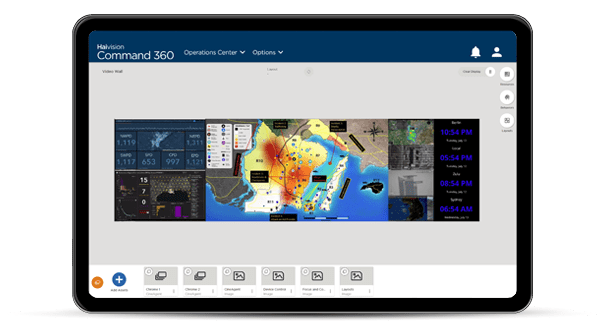The retail industry currently faces greater security challenges than ever before. Mitigating cyber and physical losses requires a multi-faceted, proactive strategy. A visual collaboration platform can be an effective component of a broad security plan. In-store cameras and video monitoring have been a staple of physical security for decades. Now, due to social and technological developments, it’s time for retail security operations to evolve beyond grainy, monochrome video feeds to centralized visual intelligence and collaboration.
Most of us think of “loss prevention” when we think of retail security. While shoplifting remains a significant threat, the industry faces growing cyber and on-site challenges. As detailed by Security Infowatch, four major dynamics drive security threats to retail operations worldwide, but particularly in North America: COVID protocols, organized retail crime, workplace violence, and civil unrest.
COVID -19
The COVID pandemic affected retailers in several ways. Communities relied on large-scale retailers like grocery, houseware, and bulk stores for food and supplies as families huddled at home for months. Retailers saw an increase in online ordering for both pickup or delivery as shoppers sought to minimize COVID exposure from walk-in browsing and check-out. While this e-commerce trend reduced in-store shoplifting, it increased cybersecurity vulnerabilities with unprecedented numbers of shoppers entering and storing personal data on retailer websites.
Even with a dramatic increase in online transactions, retailers were not free to simply shift security focus away from in-store shoppers. Many communities required stringent compliance with COVID restrictions, including masking, social distancing, foot-traffic flow, and capacity restrictions. Although enforcement of these rules varied per community, retailers were obligated to address the challenges. Many relied on video surveillance to identify breaches or confrontations among patrons with sharply contrasting opinions on COVID protocols. Coronavirus-related conflict became so common, the CDC issued guidance for Limiting Workplace Violence Associated with COVID-19 Prevention Policies in Retail and Services Businesses.
Organized Retail Crime
The teenager trying to shoplift a trendy jacket to impress friends does not meet the standard for organized retail crime (ORC). The criterium for ORC entails conspiratorial criminal attacks by two or more people. The offenders engage in fraudulent activity against retailers via well planned, structured procedures. Complex networks of organized retail criminals can operate on any scale, from local to international footprints. Types of ORC include:
- Sophisticated fraud schemes
- Deep supply chain theft
- Identity theft
- Complex return fraud
- Money-laundering operations
- Cyber fraud
- High quality counterfeiting
With ORC losses totaling more than $100 billion per year, concerted efforts are taking place to identify and track ORC associations at a national level.
Workplace Violence
Retail workers interact with an increasingly polarized population. Individuals have become bolder than ever in voicing strong positions on COVID protocols and vaccinations, political affiliations, racial issues, and expressions of gender identity. While some are happy to ‘agree to disagree,’ others welcome the opportunity to confront anyone who appears to display a contrary opinion.
The societal issues above fuel anxiety and frustration among otherwise agreeable individuals. It doesn’t take much for retail customers to lash out at each other and store employees when emotions are pushed to a boiling point. Every day we see headlines related to physical violence erupting out of social tensions, or worse, a tragic news story about a confrontation between customers and retail workers.
Civil Unrest
There are a variety of activities labeled “civil unrest” that affect retailers, some peaceful and some destructive or massively disruptive. For example, large scale physical violence or riots have at times erupted at public locations. Inevitably, retail stores occupy those shared spaces where riots or violent demonstrations are likely to occur. When store operators have the benefit of anticipating such an event by observing social media coordination or through public safety officials, they often follow procedure to shut down, lockdown, and board up the brick-and-mortar buildings. In fact, various software providers like Signal are now designing tools to “get accurate and real-time results from online data sources including blogs, forums, social media, the deep web and the dark web to detect threats to assets, brand, and data as they are emerging.”
The Visual Intelligence Solution
By centralizing risk, security, and communication strategies in a global security operations center (GSOC), retailers can more efficiently protect customers and employees as well as digital assets and physical inventory. At the heart of the GSOC, an integrated visual intelligence and collaboration platform pools countless resources to deliver the most comprehensive real-time information possible. How can retail organizations leverage this environment to improve security operations and address the issues listed above, among other threats?
- A high-performance video wall system provides an array of high-resolution displays for superior visual monitoring of site surveillance content.
- Powerful and dedicated video processing hardware delivers speed which outpaces processors built into individual displays to ensure image quality for better situational assessment.
- Dynamic content control allows security ops personnel to organize, scale, crop, layer, and manage limitless assets (IP video streams, social media, web and local applications, maps, satellite images, television tuners, etc.) across multiple device platforms for real-time, relevant intelligence.
- Distributed and remote teams collaborate across one common operating picture. This ensures all parties, even within large operations across multiple networks, are making informed decisions based on the latest, most accurate data available. Small or multi-regional operations easily and securely communicate with the parent organization as well as local police and public safety resources.
- A highly secure platform supports the most stringent cybersecurity tools to monitor and protect customer and organizational data and digital assets.
- A resilient and scalable system grows with the retail operation’s security needs, regardless of threat origination.
Haivision is proud to support retail security operations in combating physical and cyber threats. By working with retailers and other mission-critical operations, we’ve designed innovative visual collaboration systems which deliver all the features listed above, and more. Contact us today for a demo of our state-of-the-art products and more information on a customized solution for your security operations.
